|
The First Decade
| |
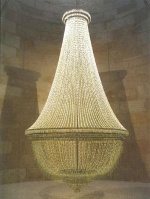 |
| |
Joana Vasconcelos, A Noiva, 2001. Aço inox e tampões OB, 470 x 220 x 220 cm. Col. António Cachola.
Joana Vasconcelos.
|
The first decade of the 21st century began in a most promising manner in Portugal. One can finally assert that there is a whole new generation emerging with a sound and coherent university-level education. In this vision we are including the context in which Alexandre Estrela and Miguel Soares organized an exhibition in 1995. Titled Wallmate, this was an exhibition of the new graduates of FBAUL, presented publicly as a clear manifest against the very institution of education where they studied, whose obsolete and incoherent options were unmasked in a text written by Rui Toscano for the catalogue. Since then, due on the one hand to the dynamic of Ar.Co with a teaching level closer to that of European and North-American artistic schools and on the other hand to a new generation of teachers at FBAUL, namely Delfim Sardo and Ângela Ferreira, and also to the blossoming of the new Maumaus School, under the direction of Jürgen Bock, the conditions of schooling were radically changed and reflected thus a substantial improvement. The new artists that emerge in this context are also aided by a wider circulation propensity, which allows for an easier access and conditions to attend foreign schools and institutions. Amongst this diversified generational group – Gabriela Albergaria, Leonor Antunes, Vasco Araújo, Rui Calçada Bastos, Catarina Campino, Nuno Cera, Filipa César, Alexandre Estrela, Pedro Gomes, André Guedes, Catarina Leitão, João Onofre, lnês Pais, Francisco Queirós, Jorge Queiroz, Carlos Roque, Noé Sendas, Sancho Silva, Susana Mendes Silva, Catarina Simões, Miguel Soares and João Pedro Vale –, most of them achieving MFAs and post-graduate studies, or attending residencies and/or international exchange programs, therefore enriching their own visual language.
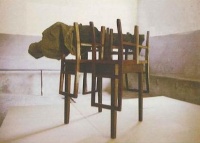 |
|
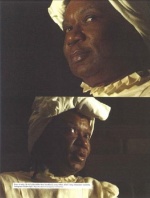 |
|
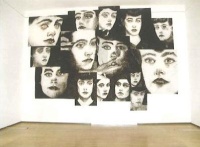 |
|
Noé Sendas, Smog III, 2000. Poliester, resina epoxida, roupa, sapatos Adidas, mesa e cadeiras de madeira, 190 x 300 x 300 cm. Vista da instalação na exposição "Runaway world", Caldas da Rainha. Col. do artista.
DR/ Cortesia do artista.
|
|
Vasco Araújo, The Girl of the Golden West (detalhes), 2004. Vídeo, 18´28´´, loop, dimensões variáveis. Intérprete: Esther Kyle. Ellipse Foundation Contemporary Art Collection.
Video Still - Cortesia do artista
|
|
Adriana Molder, Skin Job, 2005. Série de 15 desenhos a tinta-da-china s/papel esquisso, dim. variáveis. Vista da instalação na exposição "O nome Que No Peito Escrito Tinhas", Alcobaça. Col. da artista.
Adriana Molder.
|
This new generation is fluent in the "lingua franca" of contemporary art, that is to say, they do not employ a kind of constrained connotation in order to boost their own strategies of assertion anymore, as the immediately previous generation had done. In the same way, this younger generation simply started, as an aprioristic given, to dialog with and within an international panorama, erasing thus the polemic context typical of the 90s, creating an ambient in which tension between groups or directions is non-existent and in which a less sectarian debate is made possible.
Where curatorial initiatives are concerned, it is also in this recent period that Portugal reaches a platform of "theses", so to speak: 2000 was an extremely prolific year in projects that not only underlined the personality and the position of the curator him or herself but that also consolidated serious research on the main idea and the subsequent sustained argumentation. The Projecto Mnemosyne (Mnemosyne Project) curated by Delfim Sardo for the Encontros de Fotografia de Coimbra proposed an archaeological vision upon the photographic medium, as well as a historiographic and genealogical research, which only amplified and deepened the Encounters’ usual concerns and ambitions.
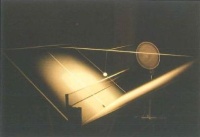 |
|
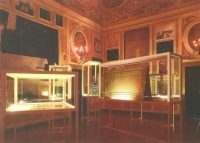 |
|
Ricardo Jacinto, Ping-pong piece, 2000. Mesa e bola de ping-pong, ventoinha e som stereo, 280 x 150 x 150 m. (aprox). Col. Caixa Geral de Depósitos.
Ricardo Jacinto.
|
|
João Penalva, R., 2001. Vista da instalação, Pavilhão de Portugal, XLIX Bienal de Veneza, 2001.
Mário Valente.
|
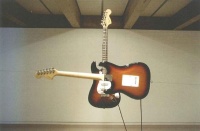 |
|
 |
|
Carlos Roque, Harmónico. Loving Guitars, 2001. 2 guitarras eléctricas Fender Stractocaster, 2 amplificadores Vox, 2 cabos jack e 4 cabos de aço, dimensões variáveis. Col. PCR.
DR/ Cortesia do artista.
|
|
Julião Sarmento, Following Veins, Discovering Paths (Pornstar), 2002. Técnica mista sobre tela, 78 x 105 cm. Col. Douglas Gordon.
DMF.
|
Jürgen Bock was the curator of several exhibitions held at the CCB, whose generic name was Project Room and brought to Lisbon for the first time artists such as Heimo Zobernig, Allan Sekula, Eleanor Antin or Renée Green, among others. This project was underlined and strengthened by a debate that gathered the participant artists with critics and theoreticians, leading to the publication of a catalogue, adding up to what was an unusually consequential initiative.
It was also during this period that the project Slow Motion curated by Miguel Wandschneider (who would later on become Culturgest's artistic director) was presented. An event that proposed an anthological view on Portuguese video and super-8 film production, it was novel work where the research and material-gathering of the field were concerned. This project was presented in the following years at ESTGAD (Caldas da Rainha) and at the CAMJAP (Lisbon).
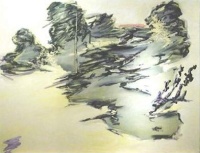 |
|
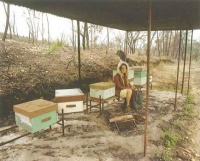 |
|
João Queirós, S/título, 2006. Óleo sobre tela, 190 x 250 cm. Cortesia Galeria Quadrado Azul.
GC.
|
|
Suzanne S. D. Themlitz, da série Territórios e Estagnações Ambolatórias, 2006. C-print, 81 x 100 cm. Cortesia Vera Cortês Agência de Arte.
Cortesia da artista.
|
Related to this context, we should mention the exhibition organised by Pedro Lapa for a production of the Maumaus School: More Works about Buildings and Food, held at the Fundição de Oeiras. This event positioned it self right at centre stage of the critical discussions of its time, presenting in Portugal artistic proposals such as the ones protagonised by Franz Ackerman, Fabrice Hybert, Liam Gillick, Tobias Rehberger, Superflex, N55 and the Atelier van Lieshout, among others.
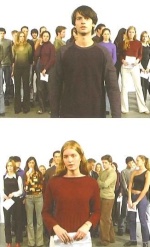 |
|
|
João Onofre, Casting, 2000. Vídeo, cor, som, 12´59´´. 274 x 370 cm. Cortesia do artista / Cristina Guerra Contemporary Art.
Video Still - Cortesia do artista.
|
|
Already in 2001, underlining the fact "I´air du temps" had definitely settled in Portugal, Francisco Vaz Fernandes curated for the Calouste Gulbenkian Foundation the exhibition 7 artistas ao 10º mês (Seven Artists, On the tenth Month), revealing an evident conscience on the very notion of "exhibition", and a concern for the notion of "collective", aiming not at a mere, simple lining up of a few individual names but at really creating a global notion of "display", proposing something far bigger than the sum of its parts.
Also in 2000, two of the most important contemporary Portuguese galleries were opened, namely the Cristina Guerra and the Filomena Soares galleries, both located in Lisbon and which would define the exhibitions course and nature for the immediate future. The new dynamics that would emerge announced already a new and evident recentring of gallery activity in Lisbon, leading thus to, in the mid 2000s, the opening in Lisbon of franchises of the most important galleries from Porto (such as Fernando Santos, Quadrado Azul, Graça Brandão and Presença), Notwithstanding the significant dynamic created at the outset of the new decade, in the summer of 2003, lAC was closed down and became part of the new lA (Institute for the Arts), or to be more precise, it was fused with the IPAE (Portuguese Institute for Spectacles Arts), This governmental decision was very criticized by many cultural agents, given the fact they understood this as the heralding of an undesired setback.
Contrarily to the 90s, a time centred in an artistic reflection upon the social plane, the new millennium strides forward in a very marked disciplinary direction, which does not mean that people are returning to close ended practices but rather that the artists are very conscious of each medium's nature and that that is the very semantic of their syntaxes.
| |
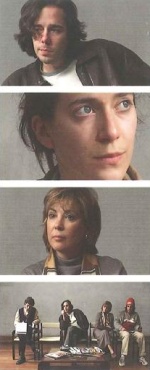 |
| |
Filipa César, Lull, 2002. Vídeo, Pal-plus, cor, som, 10´40´´. Cortesia da artista / Cristina Guerra Contemporary Art.
Video Still - Cortesia da artista.
|
Alexandre Estrela (who had his first major anthological exhibition in 2006 at the Museu do Chiado) seems to be one of its best examples with works such as Making a Star, the video recording of the precise moment when one switches off a television set and the image's disappearance produces a luminous point, or "camera", in which a convex mirror substitutes the lenses in the video projection of a camera's image, among many other works in which the medium is a "mise-en-abyme" of references. Artists such as CarIos Roque and Rui Toscano, on the other hand, explore the same medium's transparency in order to annul the message, as we can see in Sprawl, Infinity or Toscano's many video-landscapes and Roque's sound installations, such as Harmónico, Loving Guitars, not to mention all his practices in the fields of drawing and painting. This same strategy is quite evident in the photographic works of Daniel Malhão and Nuno Cera, who discarded the poetry of the photographic image as it is present in the work of Daniel Blaufuks or PauIo Nozolino, turning rather to the exploration of a self-referential lexicon.
As for Sancho Silva, Leonor Antunes and André Guedes we find them to be artists who deal with space as an intersection between matter and memory, in order to deconstruct both.
A conscience for communication and community was not put aside though. It is actually centre-stage in the works of Filipa César. Within the horizons of this period we could mention the reflection on the subject and its "agencement", being present in João Onofre's work.
Vasco Araújo and João Pedro Vale bring together the questioning of individual identity as an analysis (deconstruction and swerve, theatralization and reconstruction) of the collective social and cultural imaginaries.
We may say, which it is only to be expected as the proverbial "sign of the times", that there is a profound difference here, establishing a very distinctive trait between the attitudes of these artists with that of the ones of the previous generation such as Ângela Ferreira, Miguel Palma, and João Penalva, with the exception of João Paulo Feliciano who revealed already the "nonchalante" propensity of many of the 2000 artists.
It lies in the absence of the notion of self-agency as well as a sort of political disinvestment. If we are dealing with a research upon the Other when we come across Ângela Ferreira's work, or an investment upon the social plane with João Tabarra's, when we turn to the visual art production of the first years of the present decade we find a class of artists that - illustrating the maxim that a man looks more like his times than like his parents – being the product and the producer of their own post-modern condition, can only think of the Other as a nostalgic or an ironical projection or both.
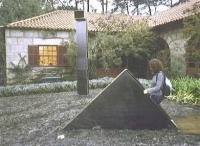 |
|
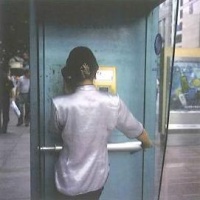 |
|
Sancho Silva, Sub-urbe, 2002 (Parque Serralves). Contraplacado para cofragem e espelhos, 250 x 90 x 500 cm. Cortesia do Artista.
Sancho Silva.
|
|
António Júlio Duarte, #605 Shangai, 2002. Ilfochrome colado em Dibond, 50 x 50 cm. Cortesia Módulo - Centro Difusor de Arte.
|
 |
|
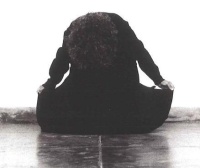 |
|
Pedro Cabrita Reis, Absent Names, 2003 (interior), site-specific. Alumínio pintado, cobertura de feltro alsfático, aparelhos de ar condicionado, lâmpadas fluorescentes, 400 x 1000 x 600 cm. Col. do artista.
DMF.
|
|
Helena Almeida, Eu Estou Aquí, 2005. Fotografia a preto e branco, 125 x 125 cm. Col. da artista.
Cortesia da artista / Cortesia Instituto das Artes.
|
As we reach the middle of this decade, we constantly witness the consolidation of new authorial paths, some of which marked already by the first signs of international recognition. For example, we may name Adriana Molder and her impressive portraits produced by an original technique, Carlos Bunga and his space construction-deconstruction work, and João Maria Gusmão and Pedro Paiva as a duo who, through installations and short films of unexpected effects, create a universe of imponderable situations, from a unique theoretical stand point and in which the attraction towards theme metaphysic shares the same breadth as their humour over the contingencies. Other names like Ana Cardoso, Pedro Barateiro, João Leonardo and Francisco Vidal are also worthy of our attention.
The Portuguese artistic milieu has also been extended further by the efforts of curators such as Miguel Amado, Filipa Oliveira, Nuno Faria and Ricardo Nicolau as well as by critics such as Nuno Crespo, Celso Martins, Óscar Faria e Sandra Vieira Jürgens.
In 2006 it is also important to highlight the opening, in Cascais, of the Art Centre of the Ellipse Foundation, an ambitious international contemporary art collection.
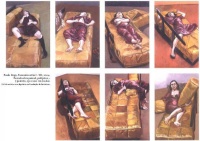 |
|
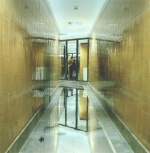 |
|
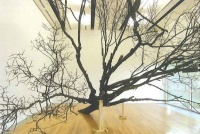 |
|
Paula Rego, Possession series I - VII, 2004. Pastel sobre painel, políptico - 7 painéis, 150 x 100 cm (cada). Col. da artista, em depósitos na Fundação de Serralves.
DR/ Cortesia Marlborough Fine Art, London.
|
|
Leonor Antunes, Fichet, 2003. Culturgest, Porto. Escultura - placas de aluminio polido de 1 cm. de espessura. Col. Caixa Geral de Depósitos.
Pedro Tropa e Teresa Santos.
|
|
Gabriela Albergaria, Árvore, 2004. Ramos de árvore e parafusos. Vista da instalação no Project Room do CCB. Cortesia Vera Cortês Agência de Arte.
Simon Chaput.
|
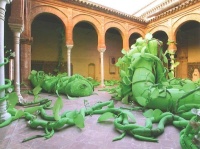 |
|
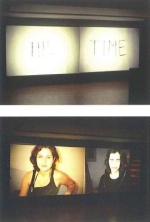 |
|
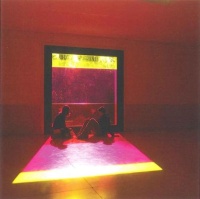 |
|
João Pedro Vale, The Secret Garden, 2004. Collants, ferro, arame e esferovite, dimensões variáveis. Col. do artista / Cortesia Galeria Filomena Soares.
DR/ Cortesia Vera Cortês Agência de Arte.
|
|
Nuno Cera, The time is now, 2004/05. Série The time is now, 486 slides, instalação em diaporama, dim. variáveis, slides de 35 mm. a cores, som. Col. do artista.
DR/ Cortesia do artista.
|
|
João Paulo Feliciano, Yellow Pink Red Window, 2004. Janela existente (2,5 x 2,5 m), vidro, filtros de cor, madeira, projectores com lâmpada de iodetos metálicos (exterior). Instalação: Serralves Museu de Arte Contemporânea, Porto. Cortesia do Artista / Cristina Guerra Contemporary Art.
Pedro Lobo.
|
One has to acknowledge the fact that, as a consequence of this group of structural changes and of the exponentiation and internationalization of the scene, the national artistic production has become so diversified that it has made many of the concepts we have used above as obsolete, notions such as "group" or "generation" which prevents us from, at least for the time being, assure any sort of generalizing systematization.
For those who are used to travel back and forth with in the routes and roads of the world of art, one must be prepared to address that unavoidable question, a question that may arise at any moment: "Is there anything interesting going on in your country?” in this case, Portugal.
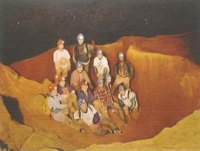 |
|
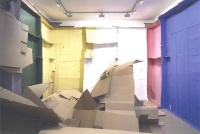 |
|
Bruno Pacheco, Moon Cave, 2006. Óleo sobre tela, 160 x 220 cm. Cortesia Galeria Quadrado Azul.
GC.
|
|
Carlos Bunga, Elba Benitez Project, 2005. Cartão, fita adesiva, tinta mate, mesa de luz e slides, dim. variáveis. Cortesia Elba Benitez Galeria.
DR/ Cortesia Elba Benitez Galeria.
|
Twenty years ago, against the old, typically Portuguese lament, the usual response to this was the following: "There is a new generation of assertive and consistent young artists that you must know of as soon as possible". We still use the same answer today.
This new generation of Portuguese artists of the 21st century is part of the first generation to be born after the 25th of April and its creative attitude is one of the most optimistic expressions of the cultural maturity of the Portuguese democracy.
Being in their 30s notwithstanding they have taken the control of the meaning of their works and careers with the fully developed easiness that we usually come across with in larger, more cosmopolitan centres.
The times have changed. We are not witnessing a challenging stance similar to that with which the 60s generation confronted fascism. We are not witnessing an enthusiastic euphoria similar to that through which the 80s claimed a contemporaneity with the world.
What we see today is rather the artists themselves making a clear-cut assertion of that very condition without necessarily suffering the traumas or the struggle against the traumas naturally brought about by the ancestral Portuguese inferiority complex.
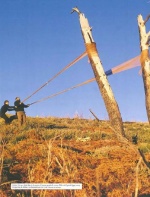 |
|
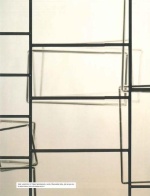 |
|
Pedro Paiva e João Maria Gusmão, O homem projéctil, 2005. Slide de O grande jogo, 2005. Projecção de slides, 20 diapositivos 6 x 6 cm.
Cortesia dos artistas.
|
|
José Loureiro, S/Título (pormenor), 2006. Óleo sobre tela, 180 x 190 cm. Cortesia Cristina Guerra Contemporary Art.
DR/ Cortesia Cristina Guerra Contemporary Art.
|
Artists such as Vasco Araújo, Filipa César, João Onofre and João Pedro Vale have studied, travelled, lived and exhibited in Portugal and abroad quite naturally. They were able to create personal territories from the very first years of their artistic formation and through their first solo exhibitions (that they had when very young) and they were also able to consolidate very specific work stances and courses. These are the elements that show the warrants of professional competence and the imaginary's autonomy that make up the soundest sign of the existence of a full-fledged author. We must establish a dialogue with these artists. This is the best gift our punished senses can ask for: to discover these new authorial territories as they are being constructed. New names with doors ajar in order to challenge and stimulate our imagination.
A clear conscience of their own condition as artists, the consideration of the individual's affirmation as aesthetic construction and not as declaration of intentions, a congenial cosmopolitanism, a dedication to work: these are the reasons why we must trust and have confidence in this new generation.
|